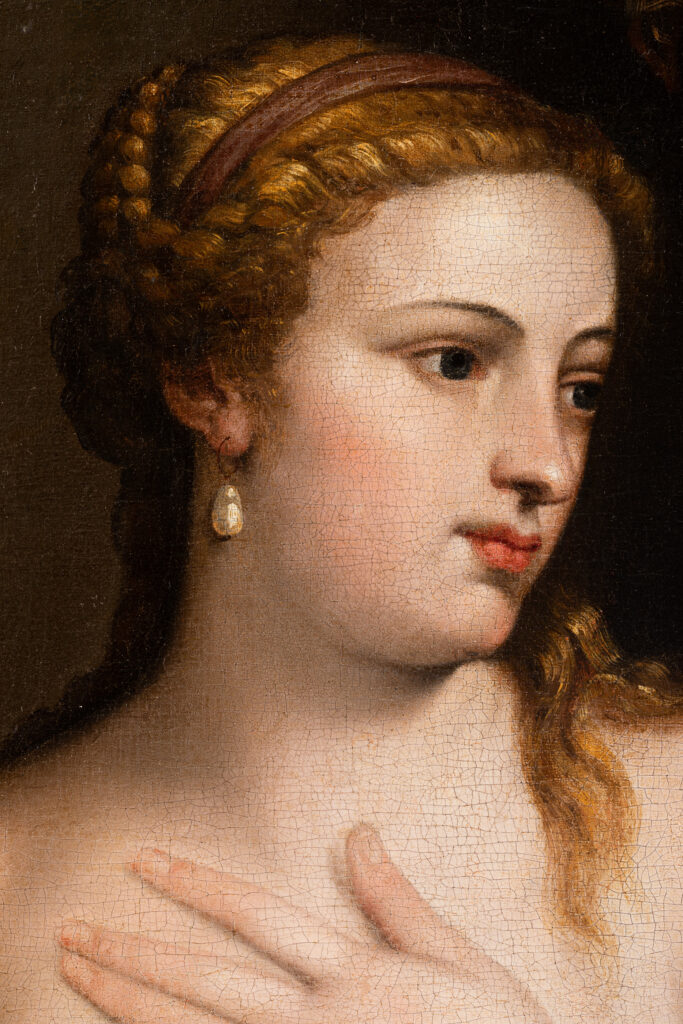This beautiful large-format oil on canvas depicts the theme of Venus with a mirror. It is based on the composition of Titian’s 1555 painting, now in the National Gallery of Art in Washington. On the left, Venus is depicted naked, her body partially covered by a cloak. Her hair is plaited in a bun and her head is turned towards a mirror. The mirror is held by her son, Cupid, who can be recognised by his attributes, the arrows and wings. The position of Venus’ hands refers to the Venus pudica, an iconography taken from the model of the Venus de Medici, a Greek sculpture made in the first century BC.
Greek sculpture made in the 1st century BC. The goddess is depicted surprised when she emerges from the water and tries to hide her private parts. Very popular in modern times, the Venus pudica is one of the most popular ancient themes for artists and their studios, celebrating the ideal beauty of women. This iconographic choice brings eroticism and sensuality to the composition.
The theme of the mirror was also very popular with artists, especially in Venice, which in the time of Titian, Veronese and Tintoretto became the city of reflections even in its pictorial production.
Fascinated by the works of Flemish painters such as Jan Van Eyck, Italian painters used this tool not only to give viewers a new angle of view but to focus their gaze on the subject. The mirror used in the compositions then appears as a tool that reveals the reverse side of the painting and reveals what is hidden from our eye. This play with the reflection also allows for a work on brilliance. Titian adorns his Venus with jewels and a richly embroidered cloak, giving the whole a certain preciousness.
In our painting, the artist chose to represent his Venus with some of these elements such as the pearl, symbol of her miraculous creation from water. Following an expertise carried out by Mr René Millet, we can affirm that the work dates from the first half of the 17th century and that the painter is a disciple of Titian and the Venetian school. Nevertheless, although he chose to respect the model, the artist adapted to the taste of his time and purified the composition. The choice of colours also bears witness to this: the colorito of the Venetian school is left behind for a more reduced range of colours, dominated mainly by neutral and natural tones. Only the sheet lying in the background is distinguished by its red colour. These characteristics are reminiscent of the Caravaggio paintings of the early seventeenth century, especially as the painter chooses to use very dark tones that contrast with the white of Venus’ skin, creating a certain sense of mystery. Venus’ skin, creating a certain play of light and shadow reminiscent of Caravaggio’s clarobscuro.
Titian’s painting in the National Gallery of Art in Washington served as a model for his students, who produced model for his pupils, who produced numerous variations on this theme. Among them, a painting exhibited at the Musée des Beaux-Arts in Bordeaux entitled La Toilette of Venus with a lover holding up the mirror, which has a composition identical to our painting. The details are the same, even in the image reflected by the mirror.
While Titian focuses on the work of the reflection of the figure, his two followers chose to concentrate on the gaze that the goddess gives herself and thus depict a moment of contemplation. Our Venus in the Mirror is therefore a fine example of the artistic production of the early 17th century. The artist respects the tradition by taking the model of a great master who was himself inspired by the antique. However, he was able to adapt to the taste of his time by taking up certain elements of Caravaggio’s painting. This work presents the goddess from a sensual and erotic angle, which she herself discovers through her reflection.






